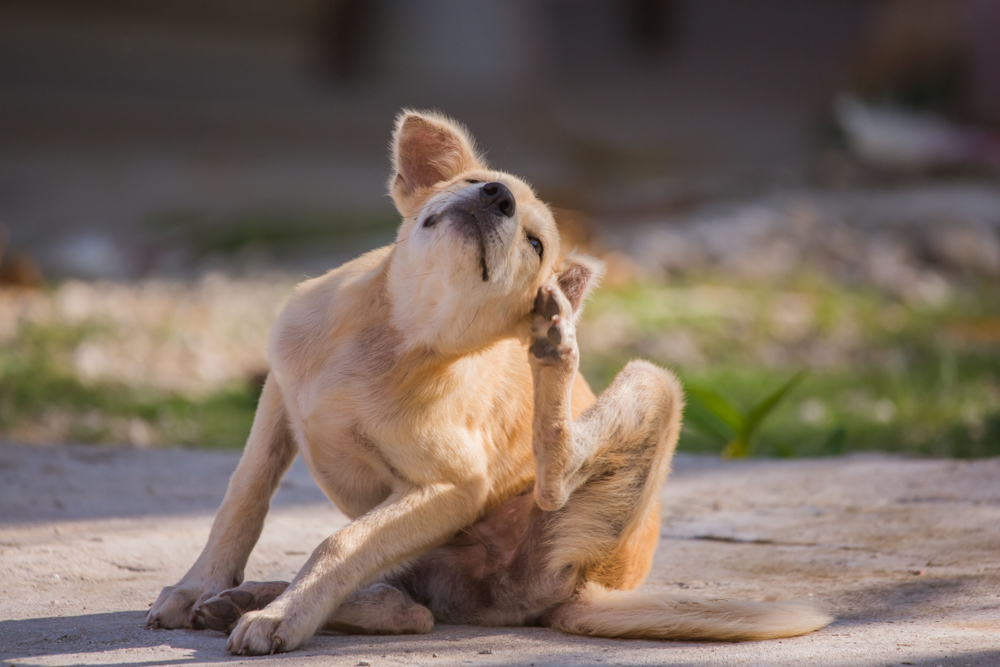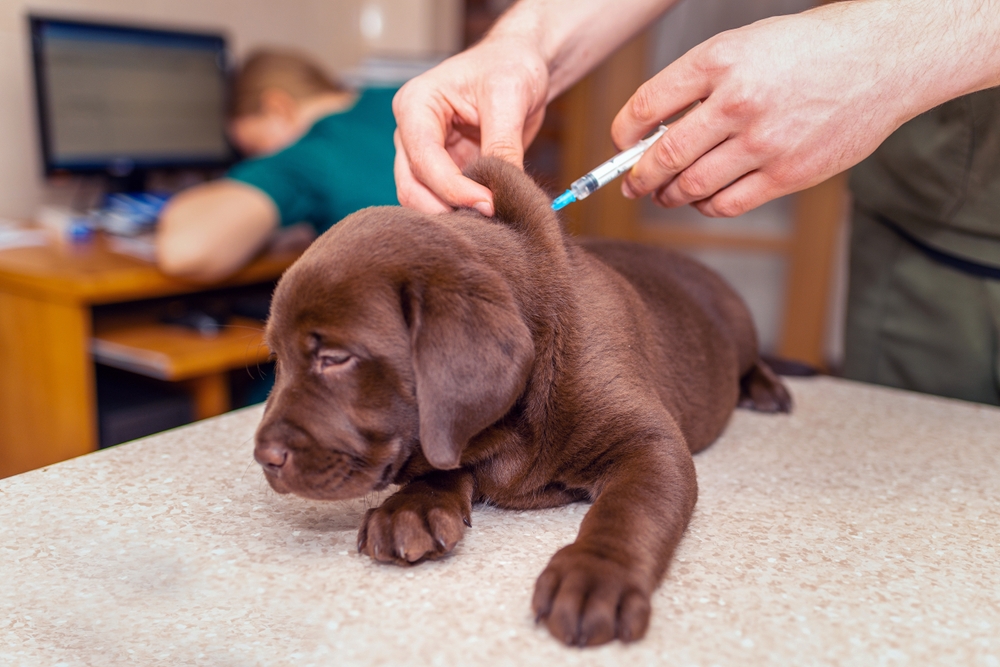While it is normal for puppies to shed some hair—particularly as they transition to an adult coat—it’s not normal for them to lose so much hair that they develop bald spots. Alopecia is the medical term for abnormal fur loss that can either result in bald spots, patchy fur, or just thinning fur. If your puppy has developed bald spots, it can be a sign of an underlying health concern, so it is important to have them examined by your veterinarian to determine the cause.
Fortunately, most bald spots can be effectively treated, and your puppy will be back to their healthy haircoat in no time. This article will explore eight common reasons your puppy may have developed bald patches and signs to watch out for.

The 8 Reasons a Puppy Can Have Bald Spots
1. Fleas

These pesky parasites are unfortunately common, even in young dogs. Fleas may be small, but they can jump relatively long distances and are easily transferred from other dogs and animals your puppy comes into contact with, or they can be picked up from the environment. You may be able to see the fleas themselves, or you may see flea dirt (flea droppings), which can look like dirt or specks of coffee grounds in your pup’s coat.
Fleas bite and feed off your puppy’s blood, causing itching and scratching, and it’s this self-trauma that results in hair loss and bald patches. Fleas can also transmit other parasites, such as tapeworms, and a heavy infestation can even lead to anemia due to the blood loss.
If you suspect your puppy may have fleas speak to your vet straight away for advice. Fleas are easily treated but you need to make sure you are using the right product for your puppy’s age and size. Your vet can also check your puppy over to make sure they are not suffering from other issues that need treating.
2. Mites
Three types of mites commonly infest dogs and can lead to bald spots: Sarcoptes scabiei, Demodex canis, and Otodectes cynotis (the ear mite).
- Demodex mites are normal inhabitants of a dog’s skin. Almost all puppies get these mites from their mother in the first few weeks of life. However, if the developing immune system can’t control the number of mites, they can cause skin disease (demodectic mange) and bald spots.
- Ear mites are also common in young animals. They live in the ear canals and can cause intense irritation. The resultant scratching can lead to hair loss, especially around the ears and head.
- Sarcoptes mitesare easily transmitted from one animal to another and cause a very itchy skin condition called sarcoptic mange (scabies).
3. Ringworm

Despite its name, ringworm is actually a fungal skin infection that can lead to hair loss and bald patches. The affected skin may also be crusty and red. Ringworm doesn’t only affect dogs; it is contagious and can also spread between humans and other animals, including cats, rodents, and horses.
Dogs of any age can be affected, but puppies are among the groups most at risk, along with old dogs and dogs with a compromised immune system. Contact your vet if you are concerned your puppy may have ringworm. They may use a special lamp to check for ringworm and take samples of hair and skin to be sent for investigation.
4. Bacterial Skin Infections
Pyoderma (a bacterial skin infection) can affect the hair follicles and lead to itchiness and hair loss. It often occurs secondary to other problems like parasites or allergies. Impetigo, also known as ‘puppy pyoderma,’ is slightly different in that it doesn’t usually affect the hair follicles. Puppies with impetigo usually develop pus-filled spots on relatively hairless areas of the body, such as the tummy, so bald spots tend not to be such an obvious sign.
5. Nutritional Deficiencies

Good nutrition and healthy skin and coat are closely linked. A nutritional deficiency can affect a puppy’s hair and skin, leading to sparse hair growth and potentially bald spots. For growing puppies, having an adequate level of high-quality protein and fat is especially important. Mineral deficiencies, such as a lack of copper and zinc, can also lead to hair loss. Make sure your puppy is on a high-quality, complete, and balanced diet suitable for their age and breed. Your vet will be able to advise you and give you guidance on choosing the best food for your dog.
6. Allergies
Just like us, our dogs can develop allergies to certain things, and in dogs allergies often cause itchy skin signs. Allergens are the most common things in the environment, such as pollen, house dust mites, and molds, and dogs typically develop allergic signs between 6 months and 3 years of age. Signs include red, itchy, swollen skin, and the scratching and licking can lead to bald patches. The ears, face, feet, front legs and tummy are common areas to see skin signs, but anywhere on the body can be affected. Dogs can also develop food allergies, typically to animal-based proteins such as beef, dairy, and chicken. The age of onset of food allergies is variable, but it can affect puppies under a year of age as well. As well as itchy skin, pups with food allergies may also suffer from gastrointestinal signs such as diarrhea.
7. Injection Site Alopecia

Occasionally, a bald patch can develop at an injection site. In puppies, this can occur after a rabies vaccination, and it can also be seen after injections of long-acting steroids.
Small and toy breeds have been found to be at increased risk of rabies vaccine-associated alopecia, especially in Poodles, Bichon Frises, Shih Tzus, Yorkshire, and Silky Terriers. A hypersensitivity to the injection is thought to be responsible. The patch of hair loss and sometimes thickened skin usually develops between two and four months after vaccination.
8. Genetic and Inherited Causes
While some puppies, like the Chinese Crested, are bred to have no fur, for others, hair loss and bald areas can develop. A loss of hair from the ear flaps (pinnal alopecia) of Daschunds is one example of this. This typically starts between 6 months and 3 years of age with thinning of the hair over the ear flaps, progressing to total hair loss. It can also be seen in Italian Greyhounds, Chihuahuas, Boston Terriers, and Whippets.
Color dilution alopecia (CDA) is another example of an inherited condition that can cause patchy hair loss in dogs with dilute fur colors, such as blue and fawn, from about 6 months of age. Typically, puppies have normal coats for the first few months but then start to develop bald spots from late puppyhood, which can progress to bigger patches.
If you’re concerned about your dog’s health we suggest you speak to a vet.
PangoVet. It’s an online service where you can <b>talk to a vet online</b> and get the personalized advice you need for your pet — all at an affordable price!
</p>
<div class="su-button-center"><a href=https://www.dogster.com/ask-the-vet/"https://pangovet.com/?utm_source=dogster&utm_medium=article&utm_campaign=dog_preventative_wellness%22 class="su-button su-button-style-default" style="color:#FFFFFF;background-color:#FF6600;border-color:#cc5200;border-radius:9px;-moz-border-radius:9px;-webkit-border-radius:9px" target="_blank" rel="nofollow"><span style="color:#FFFFFF;padding:0px 24px;font-size:18px;line-height:36px;border-color:#ff944d;border-radius:9px;-moz-border-radius:9px;-webkit-border-radius:9px;text-shadow:none;-moz-text-shadow:none;-webkit-text-shadow:none"> Click to Speak With a Vet</span></a></div></div></div>"}" data-sheets-userformat="{"2":4224,"10":2,"15":"Arial"}" data-sheets-validation-definition="{"1":{"1":{"1":23,"2":[{"1":1,"3":{"1":{"1":[{"1":4,"6":1},{"1":1,"2":"="}]},"2":{"1":[{"1":2,"2":"="},{"1":3,"3":1}]},"3":"R1]S"},"4":[{"1":{"1":1,"2":21,"3":0,"4":1,"5":2236944,"6":"841046713"},"2":1}]}],"6":[{"1":{"2":{"1":2,"2":"❤️ Preventative wellness"}},"2":{"1":2,"2":676776},"3":{"1":2,"2":12574966}},{"1":{"2":{"1":2,"2":"⚠️ Urinary problems"}},"2":{"1":2,"2":676776},"3":{"1":2,"2":12574966}},{"1":{"2":{"1":2,"2":"🩺 Other"}},"2":{"1":2,"2":676776},"3":{"1":2,"2":12574966}},{"1":{"2":{"1":2,"2":"👁️ Eye issues"}},"2":{"1":2,"2":676776},"3":{"1":2,"2":12574966}},{"1":{"2":{"1":2,"2":"🐕 Behavior & training"}},"2":{"1":2,"2":676776},"3":{"1":2,"2":12574966}},{"1":{"2":{"1":2,"2":"🤮 Vomiting"}},"2":{"1":2,"2":676776},"3":{"1":2,"2":12574966}},{"1":{"2":{"1":2,"2":"🛡️ Flea & tick"}},"2":{"1":2,"2":676776},"3":{"1":2,"2":12574966}},{"1":{"2":{"1":2,"2":"🍎 Ate or drank"}},"2":{"1":2,"2":676776},"3":{"1":2,"2":12574966}}]},"2":{"1":{"1":[{"1":4,"6":0},{"1":4,"6":1},{"1":2,"3":"CONDITION_ONE_OF_RANGE","4":2},{"1":1,"2":"="}]},"3":"R0]R1]FCONDITION_ONE_OF_RANGE:2]S"},"3":[{"1":{"1":0,"2":1,"3":0,"4":1,"5":1118464},"2":0},{"1":{"1":1,"2":21,"3":0,"4":1,"5":2236944,"6":"841046713"},"2":1}]},"2":"","3":1,"4":1,"6":0}" data-sheets-validation-id="0"> If you need to speak with a vet but can’t get to one, head over to PangoVet. It’s an online service where you can talk to a vet online and get the personalized advice you need for your pet — all at an affordable price!


Conclusion
It’s important to contact your vet if your puppy has developed bald spots. Many of these causes are itchy and uncomfortable for them. The sooner the problem can be treated the better to stop the hair loss from getting worse and spreading to other areas of the body. The treatment will depend on what is identified as the underlying cause, but the good news is for the majority of puppies, the hair loss can be easily remedied, allowing a healthy coat to regrow.
Featured Image Credit: Todorean-Gabriel, Shutterstock










